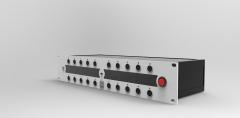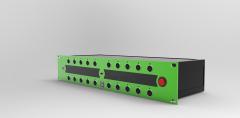-
Posts
3,633 -
Joined
-
Last visited
-
Days Won
36
Content Type
Profiles
Forums
Blogs
Gallery
Everything posted by Hawkeye
-
Yeaah :) knobbery for the ledring boards :) Thanks for running that bulk! Peter
-
Thanks for your work on this! For the MBNG based FS1R editor (with its estimated 1748 controllable MIDI parameters :smile:), bank switching by turning an encoder and displaying the current knob assignments in a few GLCDs after the bank switch would be very cool! (Off-topic: when encoders are turned/parameters are changed, it would be nice to invert the according slot graphics on the GLCD and display the changed data value, and the previous data value in its "slot"). There will probably be as many usecases as users, and it will probably not be possible to support all of them without wandering too far into generic land, which will be very hard to understand by us mere mortals :-) Many greets, Peter
-

Installing a headphone jack with volume control in MB6582
Hawkeye replied to Johey's topic in MIDIbox SID
DIYing them can save a lot of bucks for good quality: http://www.head-fi.org/t/537398/list-of-diy-headphone-amplifiers There you´ll find the full spectrum from solid state, hybrids, tube-driven and portable ones :smile: I´ve read good things about the CMOY portable one, it can also be used to properly drive your bigger sized quality phones when you are on road/plane with a tiny mp3 player/phone. It is driven by 4560 opamps, uses two 9v batteries for a bipolar supply with lots of headroom and fits into a metal tin box :-) http://en.wikipedia.org/wiki/CMoy -

Installing a headphone jack with volume control in MB6582
Hawkeye replied to Johey's topic in MIDIbox SID
The installed BC547 transistor on the MBSID is not meant as an amplifier, rather a protection for the SIDs - thus the output can only be considered a "line" out. But, as for many line out devices, the output levels were high enough for small normal "ipod" headphones for me. If you intend to use larger headphones with bigger "drivers", I´d strongly recommend to use a headphone amp (which usually also offers volume control). You can reduce volume levels by using a stereo logarithmic potentiometer, of e.g. 10k, 50k, or 100k value. Many greets, Peter -
Thx! I evaluated this tracker a while as I did some stuff on ProTracker/Amiga and FastTracker/PC back in the days... but nowadays for me nothing beats shutting down PCs/Macs and only using the almighty MBSEQ V4 hardware sequencer ;-).
-
try www.renoise.com - good stuff! :)
-

Finally learned enough Ableton to make some SID enhanced chillout.
Hawkeye replied to Stormcaller's topic in Songs & Sounds
Very well done! :-) -

Control surface PCB for 16 encoders/LEDrings Bulk Order
Hawkeye replied to Fairlightiii's topic in Bulk Orders
Mine arrived as well, and I am in the same mood as Alex! :-) They are quite heavy and I already love them! Thanks for all your work and have a great new year! Peter -

Merry Christmas / Seasons Greetings/ Happy Holidays......
Hawkeye replied to artyman's topic in Miscellaneous
Yeah, enjoy the silence, if possible :) http://www.youtube.com/watch?v=pG-JA-5xE1Y Many greets, Peter -
Ah, merci, je comprends maintenant!, c´est un projet differente :) Pour le délay analogique, j´ai choisi le "DirtBag Deluxe", un clone du Harmonix Memory Man: http://www.madbeanpe...rtBagDeluxe.pdf Joyeux Noël! Peter
-
Bonne projet! Quel chip delay analogique est-ce que tu prends? Et comment est-ce que tu controle la période? Je veux construire un delay analogique avec des MN3008 chips, mais tous les controls sont des potentiomètres manuelles... Au revoir, Pierre :-)
-

Control surface PCB for 16 encoders/LEDrings Bulk Order
Hawkeye replied to Fairlightiii's topic in Bulk Orders
But I need diz for a school project! Yesterday ;-) Hehe, just kidding, please also send mine after X-Mas and enjoy the holidays! Many greets! Peter -
Yup, nILS is right - mapping FAST to pushable encoders is incredibly helpful and really intuitive. It is FAST2, called temporary fast, or "push-to-fast", which enables this behaviour. The normal FAST toggles the state, where FAST2 is only active, while switched. Personally, i´d not recommend a 4x40 display "narrow" approach for the SEQ, because you will be covering the display with your hand when operating GP buttons 1-8 and encoders 1-8 half of the time. Many greets, Peter
-

Is there a way to get a preprinted control surface for MBSID?
Hawkeye replied to Rio's topic in MIDIbox SID
Ah, sorry for not reading properly :) If you have a custom layout, you can design one in Frontpanel Designer, the software made by http://www.frontpanelexpress.com/ and get a very nicely made aluminum panel for your needs. If you have a standard layout, like the MB6582, you can use one of the existing FPD templates: http://www.midibox.org/dokuwiki/doku.php?id=wilba_mb_6582_panels Many greets, Peter -
-

Is there a way to get a preprinted control surface for MBSID?
Hawkeye replied to Rio's topic in MIDIbox SID
Hi there, why not use a MB6582 control surface PCB? It is available in SmashTVs online shoppe :) http://www.midibox-shop.com/ Many greets, Peter -
Hi, couldn´t you just scale 15-127 to 0-127 with an in-between LPC1769? I doubt you would hear the difference and it might save some work instead of doing a full remidification :) Many greets, Peter
-

Control surface PCB for 16 encoders/LEDrings Bulk Order
Hawkeye replied to Fairlightiii's topic in Bulk Orders
Great news! Thanks for your efforts, also for sorting and counting hundreds of small parts :) Many greets, Peter -
Hi, while it may probably be coded into the MIDIbox SID program, it will require a custom pic assembly job for your needs - would probably be easier (but more expensive) to invest in a midi merger and a lpc17 core, for which numeric keypad input coding and then sending the cc would be much easier. You might even be lucky to request that feature from TK. to put it into the MIDIbox NG, he is currently working on ;-). If you can live with a set of say ten preprogrammed patches for a live set, it would work even without modifying any code in the MIDIbox NG, just program the patch changes to be emitted, when pushing a button. I think, this may be even better in a live environment. Have a LED indicate the "song" you are currently playing on, press the next button to load the next patch. And it could send to multiple synths, to program them all... This can already be done with the MIDIbox SEQ V4 Mixer by the way... so if you drive your MBSID via MBSEQ anyways, you would not need a merger... Many greets, Peter
-
-
Hm, am Kontrast liegts wohl auch nicht - zieht das Backlight vielleicht zuviel Strom über einen mageren USB-Port? Ist aber ziemlich unwahrscheinlich... wird der LPC17-Kern denn über USB/MIOS Studio erkannt, wenn das Display dranhängt?
-
Happy Birthday, Antix ;-) :clover: And thanks again for the 808 boards! (Unfortunately the build list is very long now :))
-
What else can I say :sorcerer: :thumbsup: Thanks, TK!
-
Taika-Kim - are you also using the Bourns encoders? If you tried all available different encoder types in the firmware and the problems still persist, you could try the alphas, they work very nicely for the MB6582. http://de.mouser.com/ProductDetail/Alpha-Taiwan/RE160F-40E3-20A-24P/?qs=yA6kp8fx8Y7zlmuFqx9z8g%3d%3d Many greets, Peter
-
Correct. That MB6582 baseboard also renders all these connection wires between the modules obsolete, generally resulting in a more "clean" build.



